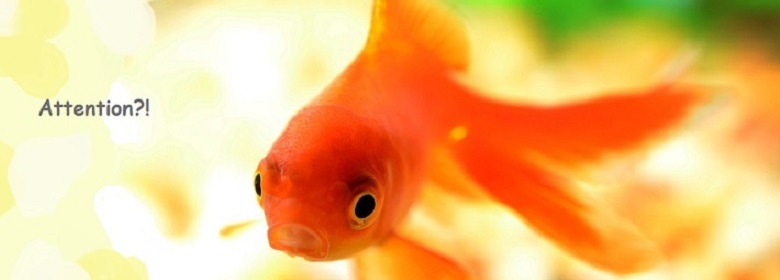In 2000, the average attention span of a human being was twelve seconds, in 2013 it had already fallen to eight seconds – and thus was one second less than that of a goldfish!
I like goldfish, but find it questionable, if their intellectual capacity is indeed higher than ours. Even if it´s only the ability to be attentive…
By the end of 2014, Microsoft Canada has conducted a quantitative survey with 2000 Canadians and additionally neuroscientific research with 112 volunteers, regarding the effects of digital lifestyles on the attention of consumers. The research results were published in mid-2015 and are so interesting that I did not just give them my attention, but also wrote this summary.
I assume thereby that the key takeaways from this Canadian study can be transferred to digital active users in the Western world. The results might especially be interesting for marketers and advertisers, because we are talking about people and thus also about consumers and (potential) customers. And:
Attention is the basic prerequisite for successful communication and accordingly for effective marketing.
Lifestyle and attention
45% of all respondents are very easy to distract from what they do.
The sustained attention span is similarly distributed over all age groups: 31% of the 18-34-year-olds, 34% of the 35-54-year-olds and 35 percent of the over 55 year-olds. Even the gender difference between men (33%) and women (31%) is rather marginal with 2 percent.
So the first takeaways are:
1. Digital behaviors and digital lifestyles correlate with the attention – however, not with the age.
2. The long-term focus erodes with increased digital consumption, social media usage and technical mind.
3. Digital lifestyles have a negative impact on a prolonged attention span
Drivers of attention
These four factors affect attention:
- Scope of media consumption
- Use of social media
- Technology adoption rate
- Multi-screening behaviour
Recommendations for an attention-grabbing marketing
So what concretely can marketing and advertising do to gain more attention and thus to achieve an increased responsiveness of consumers?
1. Be clear, personal, relevant and to the point.
2. Be different, defy expectations, and use simplicity to focus on your message
3. Embed calls to action, be interactive and involve your consumer, and provide consistent experiences across all devices.
What users see in one glance often decides what they will do next. If they are overwhelmed by the input or if they lack motivation to process it, their mind will not accept it. Therefore:
- Avoid unnecessary information
- Eliminate distractions
- And: If something does not play a significant role, it is not necessary!
Conclusion
The digitization per se is not a threat for marketers. It provides a number of challenges, but also creates considerable opportunities.
The ability to remain focused on a single task correlates with the volume of media consumption, social media usage, multi-screening behaviour and technological adoption. Accordingly digital lifestyles affect the ability to remain focused for extended periods of time.
Introducing secondary screens reduces the selective attention. Since the spread of multi-screening increases and consumers continue to adopt new technologies, the trend towards a decline in attention span will continue.
Increasing digital lifestyles make people more efficient in information processing and in encoding memories. This means that brands need to find more creative and increasingly insistent ways to market themselves and to involve consumers.
Brands also have to say goodbye to the demographic segmentation because digital lifestyles and behaviors are much more closely linked to attention as to age.
© Simone Philipp Management 2016
Source: Microsoft Research Report „How does digital affect Canadian attention spans?”







